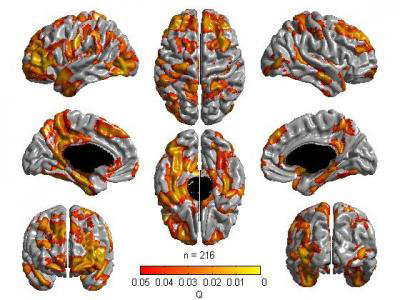Socialites and Curmudgeons: Two Brain Types

Socialites and curmudgeons not only have different party demeanors, they may also have different brain structures, a new study suggests. But what came first — the incentive to charm or the bolstered brain anatomy — is still a matter of debate. Forty-one randomly selected men filled out a questionnaire assessing their own tendency to, say, "make a warm personal connection." Those who reported being sociable and emotionally demonstrative also tended to have denser cell concentration in two brain structures: the orbitofrontal cortex and the ventral striatum, said the study's head researcher Graham Murray of the University of Cambridge in the United Kingdom. The research was published in the May 20 issue of the European Journal of Neuroscience. Chicken or egg Many studies have found correlations between the size of a particular brain structure and physical behavior, such as the classic finding that taxi drivers often have more developed hippocampi, structures associated with spatial memory. Whether the above-average geographic abilities existed before or only developed after the subjects became cabbies is unclear. The burgeoning field of social neuroscience is producing similar findings. For example, the structural research by Murray and colleagues is backed by a recent study published in Nature Neuroscience and led by Michael Cohen. He showed that strong neuronal connections between the orbitofrontal cortex and striatum were also associated with social pleasure. "Connectivity encourages growth of brain regions," Murray said, so taken together the studies suggest two causal relationships. A particular brain composition could create a warm personality, but experiencing social behavior could also create a social brain, he said. Most likely it is both nature and nurture acting in tandem, creating "a snowball effect," Murray theorized. Experience spurs brain growth, brain growth influences behavior, behavior affects experience and around we go. Personality develops most rapidly during childhood and adolescence, Murray said, but traits are never completely fixed. Even in adulthood, he continued, "social experiences could have their effect by changing brain structures over time." Key to Survival The identified brain areas also respond to pleasures, such as food and sex, that are necessary for species survival. Over the course of evolution, socializing may have also become a critical need, Murray said. "Humans and our ancestors became the smart animals that we are because we had to deal with one another," agreed David Bjorklund of Florida Atlantic University, who was not involved in the current study. Social traits likely developed in response to certain environmental pressures, such as lack of food or extended juvenile periods, requiring humans to learn to cooperate, he said. While other animals take pleasure in socializing, humans enjoy it in a definitively intricate way. We may have taken what was a simple survival mechanism and developed it into a complex pleasure, Murray said. Even today, "social interaction is vital for us," he said.
- Video – Brain-Healing Nanotechnology
- Top 10 Mysteries of the Mind
- 5 Ways to Beef Up Your Brain
Sign up for the Live Science daily newsletter now
Get the world’s most fascinating discoveries delivered straight to your inbox.
Robin Nixon is a former staff writer for Live Science. Robin graduated from Columbia University with a BA in Neuroscience and Behavior and pursued a PhD in Neural Science from New York University before shifting gears to travel and write. She worked in Indonesia, Cambodia, Jordan, Iraq and Sudan, for companies doing development work before returning to the U.S. and taking journalism classes at Harvard. She worked as a health and science journalist covering breakthroughs in neuroscience, medicine, and psychology for the lay public, and is the author of "Allergy-Free Kids; The Science-based Approach To Preventing Food Allergies," (Harper Collins, 2017). She will attend the Yale Writer’s Workshop in summer 2023.










